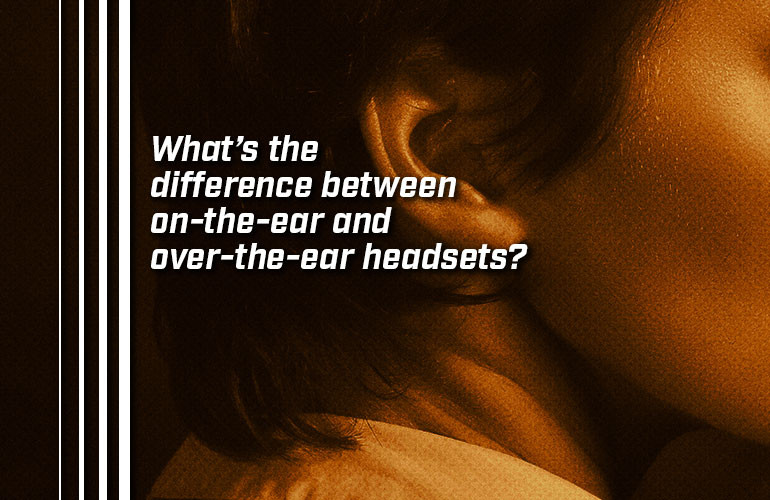At first glance, the difference between on-the-ear and over-the-ear headsets is simple. On-the-ear headsets have earcups that sit on your ears. Over-the-ear headsets have earcups that surround your ear, sitting on your head and neck. But why does this matter? Why choose one over the other?
When shopping for a Headset for Work, there are many features to consider. One of the most essential is often overlooked: where the earpads sit. Let’s explain. For the purposes of this blog, we’re just going to talk about stereo headsets, that is, headsets with two speakers.
Where does a headset position the speakers? They can be either inside your ear, as with earbuds, or outside your ear. Inside-the-ear speakers are smaller than outside-the-ear speakers, simply because of the constrained space an ear offers. As everyone knows, finding a pair of earbuds that actually fit well and sound good is quite difficult.
Headsets with outside-the-ear speakers don’t have to worry about such stringent size and fit constraints. But they still have to fit well and sound good.
And that’s where we get back to on-the-ear vs over-the-ear headsets.

The benefits of over-the-ear headsets
On-the-ear headsets like Yealink BH76 have earpads that sit on your ear. Over-the-ear headsets like Jabra Evolve2 85 have earpads that sit around your ear.
There are three primary reasons why people would choose an over-the-ear headset over an on-the-ear headset. These are, as we’ll explain, generalizations and don’t apply in every case:
- Better audio quality
- Better noise cancellation
- Better comfort
On the other hand, there are two reasons why people would choose an on-the-ear headset. Again, these are generalizations.
- Weigh less
- Cost less
Let’s get into it.
Audio quality
Over-the-ear headsets often have better audio quality than comparable on-the-ear headsets. In large part, this is for the exact same reason that outside-the-ear speakers typically sound better than inside-the-ear speakers: the speakers are bigger. Over-the-ear headsets are bigger, therefore they have better speakers. (Of course, there’s a limit to how big headphone speakers can or should be, but this correlation is generally true.)
There’s also a certain cachet to over-the-ear headsets, which you also find in the world of headphones used for music. They’re often top-of-the-line models, so manufacturers put the most effort into making them sound great. For example, the previously mentioned Jabra Evolve2 85 is the top of the Evolve2 Series.
This is not to say that on-the-ear headsets sound bad, by no means. But as a general rule, over-the-ear headsets will have better audio reproduction.
Noise cancellation
Over-the-ear headsets can reduce noise better than on-the-ear headsets. (This statement applies to noise cancellation for when you’re listening, not to noise cancellation for when you’re speaking.)
Let’s talk about passive vs active noise cancellation.
“Passive noise cancellation” (PNC) means that the headset reduces noise by its physical construction. In terms of what we’re talking about, PNC means that the earpads block out noise simply by being there.
PNC is different from “active noise cancellation” (ANC), which means that the headset reduces noise algorithmically. ANC means the headset senses surrounding sound and produces counter-sound, which acts as auditory camouflage.
If you want a fuller discussion of PNC vs ANC, check out our blog: Active Noise Cancellation vs Passive Noise Cancellation.
Because over-the-ear headsets fully encompass the ear, they will typically provide better PNC than on-the-ear headsets, which have to deal with the ridges and folds of the physical ear. This leads us to our third point: comfort.
Comfort
For many people, having earpads that surround the ear rather than sit directly on the ear is more comfortable.
To a certain extent, every on-the-ear headset has to squish the ear. Most headsets have some type of foam pad (memory foam, etc.) that molds itself to the contours of your ear, so they don’t have to squish very hard.
Over-the-ear headsets don’t have to worry about ear-squishing at all, although you might have to adjust your ears to fit within the cups that the earpads create.

The benefits of on-the-ear headsets
We’ve focused on why over-the-ear headsets are better. So why does anyone ever buy an on-the-ear headset?
Weight is one issue. Because over-the-ear headsets are bigger, they typically weigh more. If you’re using a headset all day long, those extra ounces can be really annoying.
Because over-the-ear headsets typically are top-of-the-line models, you’re going to pay a premium price for them. Many businesses and many people won’t feel that the benefits listed above are worth the extra cost.
Also, it must be said, you might not actually want the benefits listed above. If you use a headset just for talking on the phone, you might not care about having hi-fi audio quality. If you use a headset for communications, you might not want to have such good passive noise cancellation. Rather, you might want to hear yourself talk better or keep in touch with what’s happening around you better. So the “benefits” aren’t actually benefits in these cases. It’s up to you!
What about ear fatigue?
We want to end with a quick word about ear fatigue. Ear fatigue is a term for referring to how quickly a headset will cause your ears to feel tired. If you’ve ever listened to music or been on a Microsoft Teams or Zoom video call for a few hours and had your ears feel worn out, that’s ear fatigue.
Stricter noise isolation, as one gets with over-the-ear headsets, can increase the rate of ear fatigue. However, in our experience, ear fatigue differs wildly between people. For some people, a headset causes ear fatigue quickly while for others it doesn’t cause any. There doesn’t seem to be a hard and fast rule.

